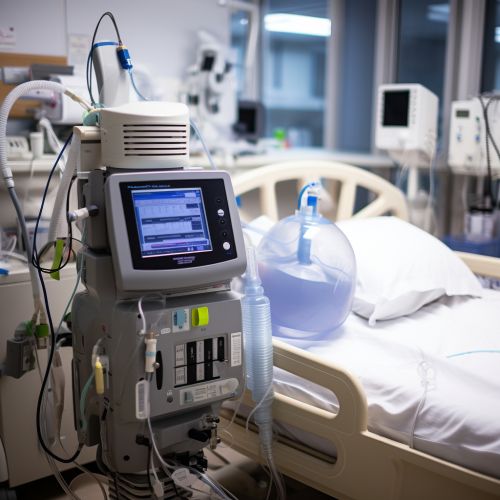Invasive ventilation
Overview
Invasive ventilation is a medical procedure used to assist or replace spontaneous breathing in patients. This form of ventilation involves the use of a machine called a ventilator to deliver breaths directly to a patient's lungs through a tube placed into the patient's airway. This is in contrast to non-invasive ventilation, where the ventilator delivers breaths through a face mask or nasal mask.
Indications
Invasive ventilation is typically used in critical care settings, such as in an Intensive Care Unit (ICU), for patients who are unable to breathe on their own due to severe illness, injury, or surgery. It can also be used in the treatment of chronic respiratory failure in patients with conditions such as Chronic Obstructive Pulmonary Disease (COPD) or Amyotrophic Lateral Sclerosis (ALS).


Procedure
The procedure for invasive ventilation involves the placement of an endotracheal tube or a tracheostomy tube into the patient's airway. The tube is then connected to the ventilator, which delivers oxygen and air into the lungs. The ventilator settings are adjusted to meet the patient's needs, including the rate of breaths, the volume of each breath, and the concentration of oxygen in the breaths.
Types of Invasive Ventilation
There are two main types of invasive ventilation: volume-controlled ventilation and pressure-controlled ventilation. In volume-controlled ventilation, the ventilator delivers a set volume of air with each breath, while in pressure-controlled ventilation, the ventilator delivers breaths up to a set pressure.
Risks and Complications
While invasive ventilation can be life-saving, it is not without risks. Complications can include damage to the lungs, infections, and complications related to the placement of the tube, such as bleeding or injury to the airway. Long-term use of invasive ventilation can also lead to ventilator-associated pneumonia and other serious conditions.
Weaning
Weaning is the process of gradually reducing and eventually stopping the use of the ventilator. This process can be challenging and requires careful monitoring of the patient's respiratory status. Various strategies and protocols are used to guide the weaning process, including spontaneous breathing trials and gradual reduction of ventilator support.
